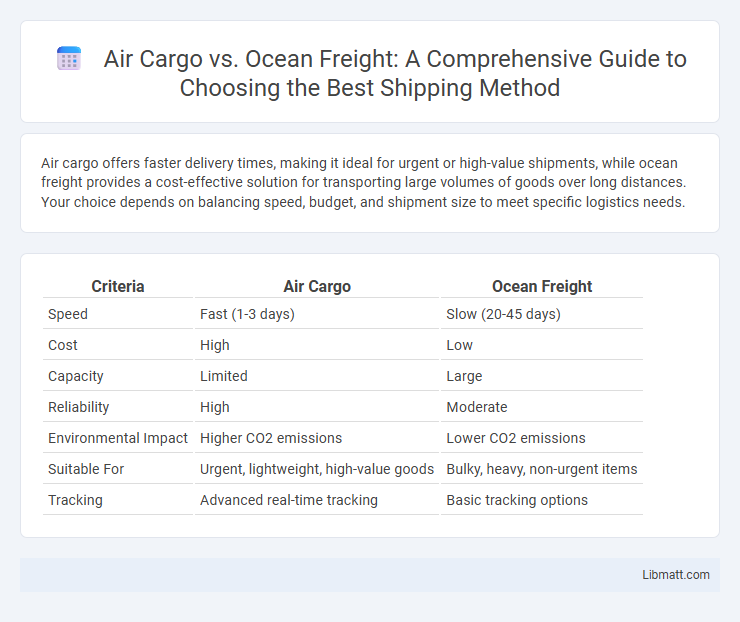Air cargo offers faster delivery times, making it ideal for urgent or high-value shipments, while ocean freight provides a cost-effective solution for transporting large volumes of goods over long distances. Your choice depends on balancing speed, budget, and shipment size to meet specific logistics needs.
Table of Comparison
| Criteria | Air Cargo | Ocean Freight |
|---|---|---|
| Speed | Fast (1-3 days) | Slow (20-45 days) |
| Cost | High | Low |
| Capacity | Limited | Large |
| Reliability | High | Moderate |
| Environmental Impact | Higher CO2 emissions | Lower CO2 emissions |
| Suitable For | Urgent, lightweight, high-value goods | Bulky, heavy, non-urgent items |
| Tracking | Advanced real-time tracking | Basic tracking options |
Introduction to Air Cargo and Ocean Freight
Air cargo and ocean freight are two primary modes of transporting goods internationally, each serving distinct logistics needs. Air cargo offers faster delivery times with higher costs, ideal for time-sensitive and high-value shipments, while ocean freight provides cost-effective solutions for bulky, heavy shipments over longer transit periods. Choosing between air and ocean freight depends on factors such as shipment size, urgency, budget, and destination.
Key Differences Between Air and Ocean Shipping
Air cargo offers significantly faster delivery times compared to ocean freight, making it ideal for urgent or high-value shipments. Ocean shipping is more cost-effective for bulky, heavy goods and large volumes, providing greater capacity and flexibility for global trade. Your choice between air and ocean transport depends on factors like speed, budget, shipment size, and destination logistics.
Cost Comparison: Air Cargo vs Ocean Freight
Air cargo typically incurs higher costs than ocean freight due to faster transit times and increased fuel consumption, with rates often ranging from $4 to $9 per kilogram, compared to ocean freight's average of $0.05 to $0.20 per kilogram. Ocean freight offers economical pricing for large, bulky shipments and is favored for non-urgent goods, while air cargo is suited for high-value or perishable items requiring expedited delivery. Freight forwarders emphasize that fuel surcharges, seasonal demand, and shipment volume heavily influence the overall cost difference between air and ocean transport modes.
Transit Time and Speed Analysis
Air cargo offers significantly faster transit times compared to ocean freight, typically delivering goods within 1 to 3 days globally, while ocean shipments may take 15 to 40 days depending on the route and port congestion. This speed advantage makes air cargo ideal for urgent or high-value shipments that require quick turnaround, reducing inventory holding costs and improving supply chain responsiveness. Your choice between air cargo and ocean freight should align with your delivery timeline priorities and cost considerations, balancing speed against budget constraints.
Cargo Types Suitable for Each Mode
Air cargo is ideal for high-value, time-sensitive, perishable goods, electronics, pharmaceuticals, and small, lightweight shipments requiring expedited delivery. Ocean freight suits bulk commodities, heavy machinery, raw materials, and large-volume cargo where cost-efficiency outweighs speed. You should choose air cargo for urgent deliveries and ocean freight for economical transport of bulky items.
Environmental Impact: Air vs Sea
Air cargo generates significantly higher carbon emissions per ton-mile compared to ocean freight, making it a less environmentally friendly option for your shipments. Ocean freight, though slower, produces substantially lower greenhouse gases and is considered more sustainable for transporting large volumes over long distances. Choosing sea transport reduces your carbon footprint and supports global efforts to minimize environmental impact in logistics.
Safety and Security Considerations
Air cargo offers enhanced safety and security due to stringent regulations, rigorous screening procedures, and advanced tracking technologies, minimizing risks of theft and damage. Ocean freight faces higher exposure to piracy, cargo tampering, and environmental factors, necessitating robust container sealing and monitoring systems. Both methods prioritize cargo integrity, but air freight generally provides superior control over security throughout the transportation process.
Flexibility and Reach of Global Networks
Air cargo offers unmatched flexibility with faster transit times and frequent departures, ideal for urgent or high-value shipments. Ocean freight provides extensive reach through vast, well-established global networks, capable of handling large volumes and diverse cargo types across continents. Your choice depends on balancing the urgency of delivery with cost efficiency and geographic coverage.
Regulatory and Documentation Requirements
Air cargo involves stringent regulatory and documentation requirements due to international aviation security standards, including detailed air waybills, customs declarations, and compliance with IATA regulations. Ocean freight requires extensive shipping documents such as bills of lading, certificates of origin, and compliance with International Maritime Organization (IMO) regulations, often including specific environmental and safety certifications. Understanding these distinct regulatory frameworks ensures Your shipments meet legal requirements, minimizing delays and enhancing operational efficiency.
Choosing the Right Mode for Your Business
Selecting the ideal shipping method depends on factors like delivery speed, cost, and cargo type. Air cargo offers faster transit times and is suitable for high-value or time-sensitive goods, while ocean freight provides cost-effective solutions for bulk and heavy shipments. Understanding your business priorities and shipment characteristics ensures an optimized logistics strategy that balances efficiency and budget.
air cargo vs ocean freight Infographic

 libmatt.com
libmatt.com